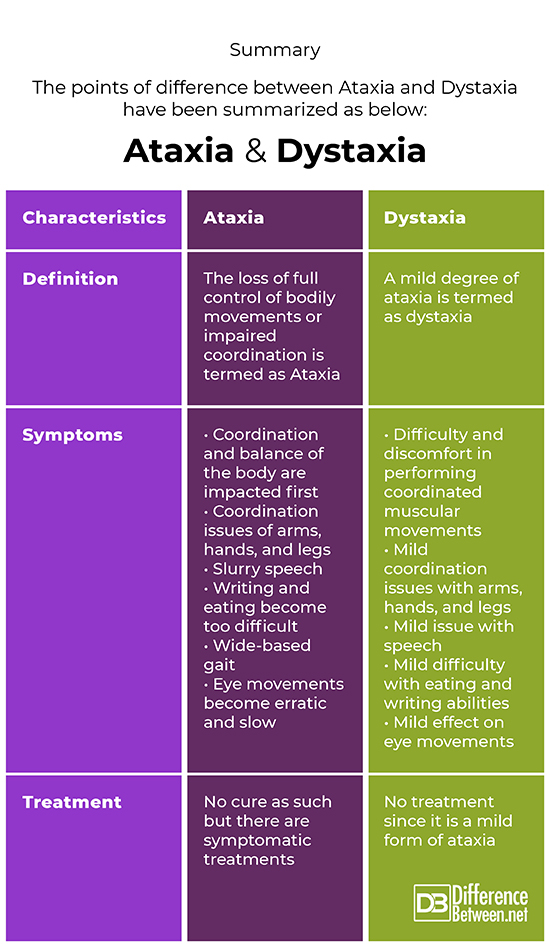Difference Between Ataxia and Dystaxia
What is Ataxia and Dystaxia?
Ataxia is defined as a degenerative disease in which a person experiences lack of coordination and impaired balance. This usually happens because of damage to brain, brain muscles or nerves. Dystaxia is a mild form of ataxia, in which there is mild shakiness in the movement due to some low level of damage to the brain.
Similarity
Both are degenerative diseases.

Ataxia
Ataxia means ‘without coordination’ and it is defined as a degenerative disease caused by issues in the central nervous system. When an individual has ataxia, he will feel discomfort in moving his body parts and the legs and arm muscles will start shaking beyond your control.

Dystaxia
It is also termed as partial ataxia or a mild form of ataxia that affects coordination and movement. It is one of the ways ataxia can impact body and the behavior. Its symptoms include mild shaky limb movements and unsteady gait.
Difference between Ataxia and Dystaxia
Definition
Ataxia
It is a neurological disorder that involves presence of abnormal, uncoordinated or impaired movements.
Dystaxia
Mild form of ataxia in which there is mild problem of impaired movement and unsteady gait
Symptoms
Ataxia
The symptoms of ataxia include
- Heart problems
- Trouble in walking
- Decreasing coordination
- Muscle tremors
- Vision problems
- Slurred speech
- Loss of fine motor skills
- Impaired balance with frequent falls
Dystaxia
The symptoms of dystaxia include
- Mild trouble in walking
- Mild problems in vision
- Mild speech issues
Treatment
Ataxia
There is no cure as such to treat ataxia. But treating the underlying cause for example tumour could help to a certain degree.
Dystaxia
No treatment since it is a mild form of ataxia
Summary
The points of difference between Ataxia and Dystaxia have been summarized as below:

FAQ
What are the 3 types of Ataxia?
The 3 types of ataxia include – proprioceptive ataxia, cerebellar ataxia and vestibular ataxia.
What is the difference between apraxia and ataxia?
Ataxia means a neurological disorder/movement disorder in which the coordination of muscles is lost. Whereas apraxia, is defined as the difficulty with skilled movement or inability to execute desired movements which have already been adopted by the person. It is caused by the brain damage or disease.
In apraxia, there is difficulty with motor planning to execute tasks or movements due to inability to understand commands.
What causes Dystaxia?
Causes are varied depending on the symptoms. The condition is usually caused by damage or harm to a part of the brain termed as the cerebellum. Other causes include mild issues associated with:
- Brain tumor
- Damage to the spinal cord or other nerves
- Deficiency of vitamin B12
- Genetic defect
- Trauma
- Thyroid problems – (Hypothyroidism and hypoparathyroidism)
- COVID-19 infection
What is Dysmetric?
A person is dysmetric if he experiences lack of coordination in movement and when pulse and the step are incorrect size. It is an error in orbit because of an abnormal rate, range, and/or force of motion. Dysmetria happens when there are lesions on your cerebellum. Symptoms include – tremors, the inability to control muscle movements, and ataxia.
What is the difference between chorea and ataxia?
Unlike ataxia, which impacts the voluntary movements quality, or Parkinsonism and is not present at rest, chorea involves – involuntary (occurring on their own), non-rhythmic, brief, unpredictable, abrupt and non-stereotyped movements resulting from continuous flow of muscle contractions from one muscle group to another resulting in jerky or dance like movements.
- Difference Between Global Warming and Greenhouse Effect - May 18, 2024
- Difference Between Vaccination and Immunization - March 3, 2024
- Difference Between Selective Mutism and Autism - February 25, 2024
Search DifferenceBetween.net :
Leave a Response
References :
[0]Albin, R. L. (2003). Dominant ataxias and Friedreich ataxia: an update. Current opinion in neurology, 16(4), 507-514.
[1]Ashizawa, T., & Xia, G. (2016). Ataxia. Continuum: Lifelong Learning in Neurology, 22(4 Movement Disorders), 1208.
[2]Sanders, W. R. (1865). Case of an unusual form of nervous disease, dystaxia or pseudo-paralysis agitans, with remarks. Edinburgh medical journal, 10(11), 987.
